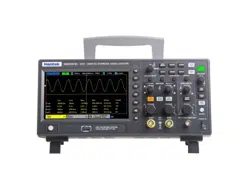Loading ...
Loading ...
Loading ...

User Manual
30 / 68
3. Press the Source softkey, turn the Multifunctional Knob to select CH1~CH2 as the trigger source.
4. Press the Polarity softkey to select Positive or Negative pulse to trigger.
5. Press the When softkey, turn the Multifunctional Knob to select the desired condition (<, >, != or =).
6. Press the Width softkey, and then turn the Multifunctional Knob to select the desired value.
7. Press the Level softkey to select Upper(V1) or Lower(V2) trigger level, and turn the Multifunctional Knob to set the
position, make the Under Amp pulse to be captured between the two levels.
8. Press the Mode softkey, turn V0 to select the trigger mode (auto, normal), and press V0 to confirm.
Auto: When the oscilloscope meets the trigger condition, it completes a trigger acquisition once; when the trigger condition
is not met, it can run the acquisition waveform freely.
Normal: When the oscilloscope meets the trigger condition, the input waveform is displayed; when the trigger condition is
not met, the original waveform is displayed.
9. Press the Holdoff softkey and turn V0 to set the time that the oscilloscope waits before a trigger to the next trigger, so that
complex waveforms are displayed stably.
2.7.10. UART Trigger
Set UART trigger:
1. Press the [Trig Menu] button on the front panel to enter the Trigger system function menu.
2. Press the Type softkey, then turn the Multifunctional Knob to select UART and push down the knob to confirm.
3. Press the Source softkey, turn the Multifunctional Knob to select CH1~CH2 as the trigger source.
4. Set the following parameters:
➢ Idle Level: Set the idle level High or Low to match your device under test.
➢ Baud: Press the Baud Rate softkey, then press the Multifunctional Knob and select a baud rate to match the signal
in your device under test. If the desired baud rate is not listed, select Custom on the Baud softkey, and then press
the Custom softkey and turn the Multifunctional Knob to set the desired baud rate.
➢ Parity: Parity Check. Choose odd, even, or none, based on your device under test.
➢ Data Bits: Data Length, Set the number of bits to match your device under test. (selectable from 5-8 bits).
5. Press the When softkey and set up the desired trigger condition:
➢ Start - The oscilloscope triggers when a start bit occurs.
➢ Stop - Triggers when a stop bit occurs on measured signal. The trigger occurs on the first stop bit regardless of using
1, 1.5 or 2 stop bit.
➢ Spec Data - Triggers on a data byte that you specify. For use when the device under test data words are from 5 to 8
bits in length
a. Press the When softkey, and choose an equality qualifier. You can choose equal to(=), not equal to(!=), less
than(<), or greater than(>) a specific data value.
Loading ...
Loading ...
Loading ...
